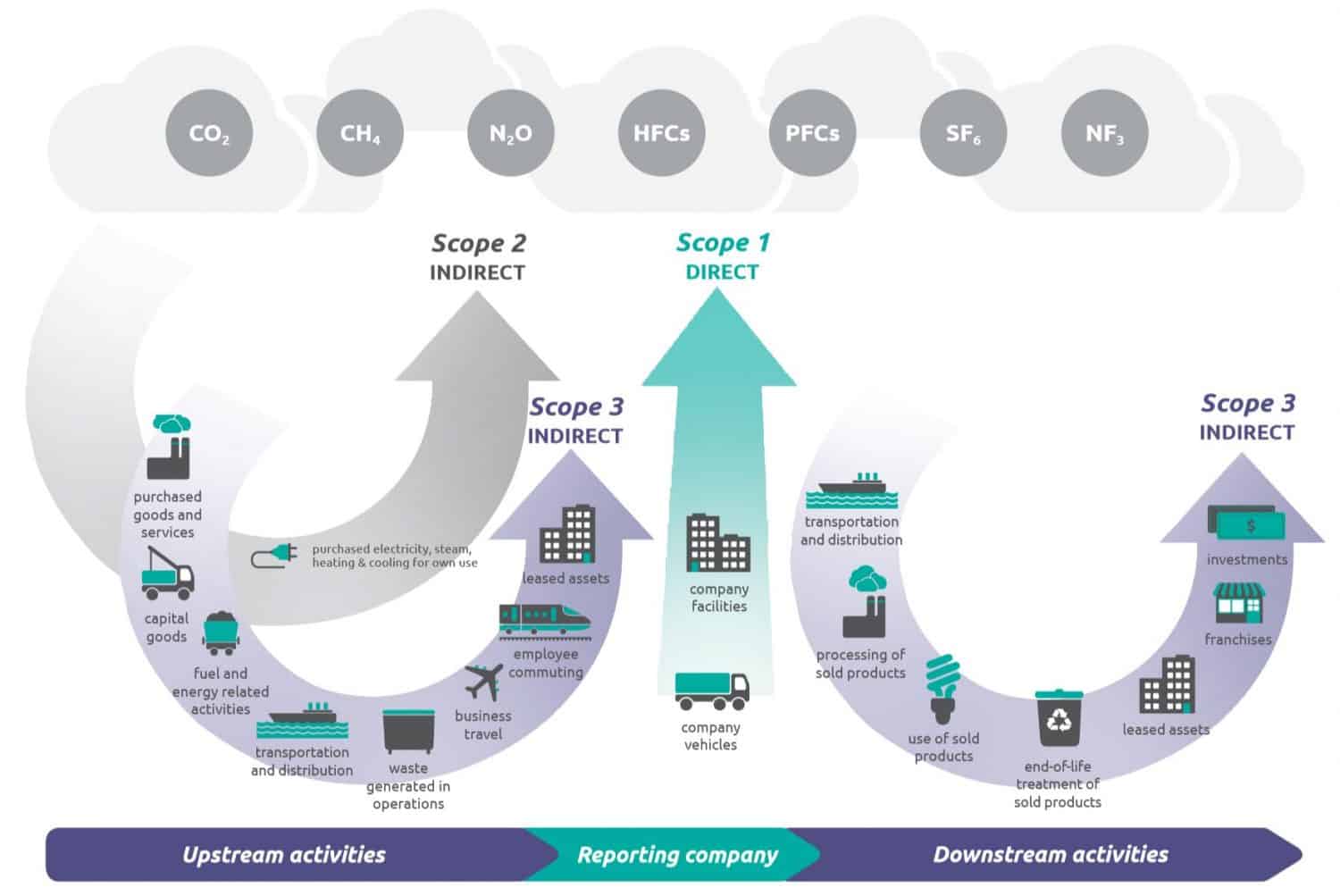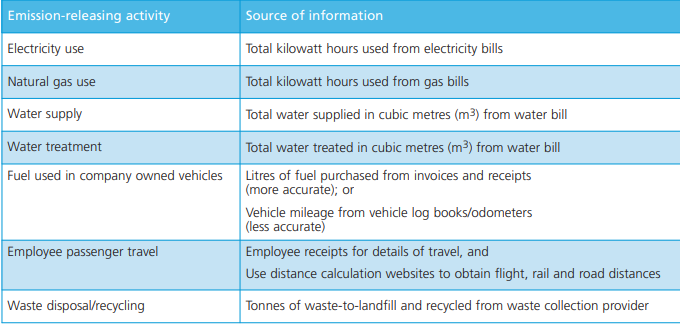The UK Government’s net zero greenhouse gas (GHG) target was announced in June 2019. By reducing GHG emissions (carbon dioxide, methane, nitrous oxide, perfluorocarbons, hydrofluorocarbons, and sulfur hexafluride), there is a greater chance of limiting an average global temperature increase to 1.5°C.
Now, one year after the net zero target was announced, many businesses are striving for a greener future, with more companies announcing ambitious climate change targets daily. However, the UK is still only at the beginning of its journey to reach the net zero target. More must be done to further reduce the GHG emitted and for businesses to be more aware of the GHG that they are releasing.
One of the best ways to start reducing your organisation’s GHG emissions is to first be aware of the current volume of GHG emitted by your company. It is important to keep track of the volume of GHG emitted, ranging from business flights to office heating, to be aware of the organisation’s environmental impact.
The different types of emissions produced by an organisation are categorised into three different “scopes,” which can each be individually assessed and then combined. The volume of GHG produced for each scope depends on the organisation. For example, according to the Carbon Trust, local councils are expected to produce 70-80% of their total footprint from scope 3 emissions. But what are the different scopes?
- Scope 1: Relates to all direct emissions emitted by the company through onsite fuel combustion from company-owned assets. Examples include company-owned vehicles, gas boilers and air-conditioning leaks.
- Scope 2: This scope relates to indirect (power) emissions from purchasing electricity to be used by the organisation. Electricity can be used for lighting the building to powering employees’ computers.
- Scope 3: The final scope includes all other indirect emissions generated by the company through assets which are not owned or which the company does not have full control over. Scope 3 covers a large percentage of a company’s emissions including business travel, waste disposal and transportation of goods.
It is now easier than ever to calculate your company’s footprint for the past financial year using the UK Governments GHG conversion factors for each scope. After gathering your company’s GHG emissions data, it is easy to understand the best areas for reduction and set goals accordingly.
Many private and public sector companies in the UK and across the world including local councils, Amazon and Barratt Developments are setting targets to reduce their GHG emissions ahead of the UK net zero target.
There are many reasons as to why your organisation should reduce their GHG emissions, mainly to help protect the environment from global warming, but also to improve an organisation’s profile and to save money.
Read our tips below to help easily understand your organisation’s GHG emissions.
1. What is the extent of your organisation’s GHG emissions?
When thinking of your organisation’s GHG emissions, it is easy to consider the direct actions that have emitted GHG emissions, such as electricity consumption from the company offices or shops. However, there are many other indirect emissions such as your employees commuting to the office, food delivered to the canteen, or even waste disposal which may have not been considered. It is important to think about all the different areas that make up the company to understand the full extent of GHG emissions caused by your business.

2. What is the best way to measure your company’s emissions?
To effectively calculate your organisation’s emissions, consumption data for each of the different scopes must be collected from sources such as electricity bills and fuel receipts for company cars over a selected 12-month period. Some values may be difficult to collect, therefore an estimation may be sufficient. The data should be recorded within a spreadsheet which can be easily updated for each month’s usage.

The collected data can then be converted using the UK Government’s GHG conversion factors, which allow for all of the different emission-releasing activities to be measured in the standardised format of CO2e, which is the unit of global warming potential of GHGs. By standardising measurements, the different types of emission-releasing activities, from natural gas use to waste disposal, can be directly compared and easily summed together. It is important that these emission-releasing activities are linked to the accumulated GHG levels, as they emit many different GHGs rather than just carbon dioxide.
These rates are updated each year, with the 2020 values recently being released. It is important to use the conversion factors for the year that correlates to the time frame that you are considering to obtain the most accurate results. For example, if calculating GHG emissions for 2019, then it is best to use the 2019 values.
Emissions can be calculated using the expression: Data x Conversion Factor = Greenhouse Gas Emission
There is also the option to calculate the company GHG emissions through online tools such as the calculator provided by the Carbon Trust, which uses the UK Government’s conversion factors. The UK Government also provides an in-depth guide to further assist with these calculations.
Although the GHG emitted by your organisation may be overwhelming at first, now that you are aware of the value and extent, it will be easier to begin taking steps to reduce your impact.
3. How should you reduce your organisation’s GHG emissions?
Once you are aware of your organisation’s total emissions, the next step is to think about how to reduce your company footprint. It is important to set realistic goals and decide on different areas that you would like to focus on to make achievable goals.
Changes range from encouraging the use of public transport for business meetings, free reusable water bottles, replacing company cars with electrical vehicles and installing onsite renewables; every little step helps move towards a greener future.
Continuing to measure the organisation’s yearly GHG emissions for future years will help monitor the company’s progress and understand the impact of your changes.
For example, Kimberly-Clark, who first measured their GHG emissions in 2005, recently announced a 35% drop in scope 1 and scope 2 emissions from their 2005 levels after setting the goal of a 40% reduction by 2022. Kimberly-Clark has reported that this large drop in GHG emissions was largely due to the installation of onsite renewables, specifically through the installation of ground mounted and roof mounted solar PV at many of their manufacturing and distribution sites. Additionally, Vodafone recently announced their plan to reduce their GHG emissions by switching to a renewable energy source including onsite roof mounted solar panels at some of their base stations to reduce their scope 2 emissions.
How can OnGen help?
At OnGen, our software suite, including the OnGen Expert and OnEfficiency, can help your organisation meet their GHG reduction targets.
The OnGen Expert™, which conducts a desktop feasibility assessment for a variety of onsite renewable technologies, calculates the carbon reduction for each technology at your site by using the Department for Business, Energy and Industrial Strategy (BEIS) grid-supplied electricity carbon intensity value. By considering carbon savings when switching to onsite renewables, the OnGen Expert highlights which technology can achieve the highest carbon savings at each site in your portfolio.
The installation of onsite renewables will drastically reduce scope 1 and 2 emissions, as electricity and heating can be produced onsite from a renewable or low carbon source rather than purchased from unsustainable sources. Scope 3 electricity transmission and distribution emissions would also be dramatically reduced, as the energy generated will be directly used onsite.
OnEfficiency, our newest software, effectively finds solutions to reduce electricity consumption at your organisation’s buildings through changes in aspects like lighting and insulation. Becoming more energy-efficient will allow for a reduction in scope 2 emissions, helping you further reach your GHG reduction goals.
As we aim to rebuild our economy with a green recovery, now is a great time to be aware of your organisation’s GHG emissions and to commit to a net zero future.
Contact us today to start your onsite renewable and energy efficiency journey.







